33,000167 guns 66,000210 guns | Date 5 December 1757 | |
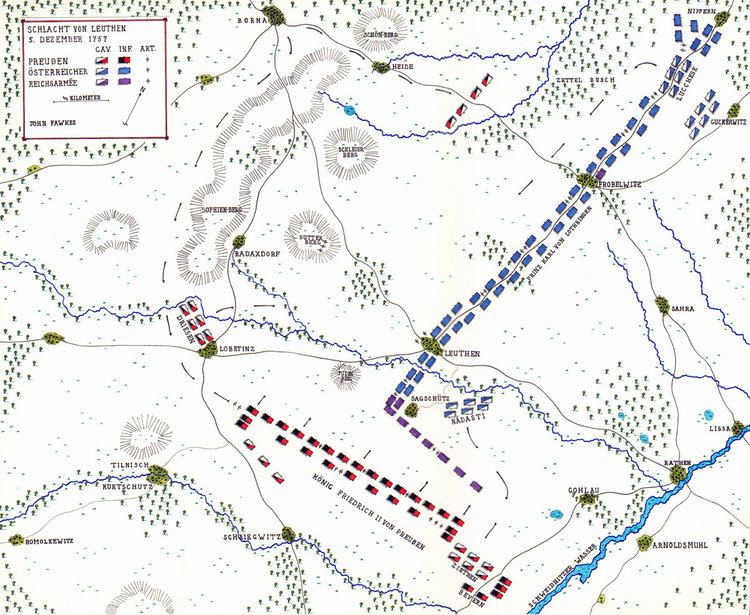 | ||
Total 6,3441,141 dead5,118 wounded85 captured Total 22,0003,000 dead7,000 wounded12,000 captured51 flags116 cannons Similar Battle of Rossbach, Seven Years' War, Battle of Kolín, Battle of Zorndorf, Battle of Kunersdorf | ||
Battle of leuthen 1757
In the Battle of Leuthen, fought on 5 December 1757, Frederick the Great's Prussian army used maneuver and terrain to decisively defeat a much larger Austrian army under Prince Charles of Lorraine, thus ensuring Prussian control of Silesia during the Seven Years' War.
Contents
- Battle of leuthen 1757
- The battle of leuthen 1757
- Background
- Terrain
- Dispositions
- Battle
- Oblique maneuver
- Attack
- Battle in maps
- Aftermath
- Casualties
- Assessments
- Memorials
- References

The battle was fought at the Silesian town of Leuthen, 10 kilometers (6 mi) northwest of Breslau. By exploiting the training of his troops and his superior knowledge of the terrain, Frederick created a diversion at one end of the battlefield, and moved most of his small army behind a series of low hillocks. The surprise attack in the oblique order on the unsuspecting Austrian flank baffled Prince Charles; it took the Prince several hours to realize that the main action was to his left, and not to his right. Within seven hours, the Prussians destroyed the Austrian force, erasing any advantage the Austrians had gained throughout the summer and fall of campaigning.
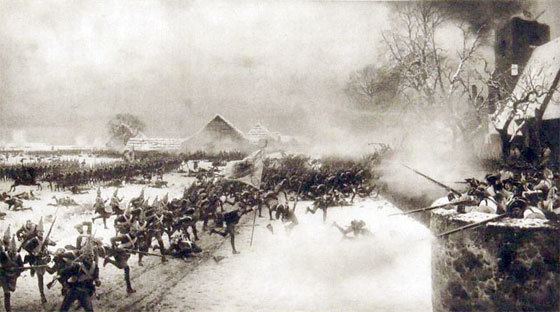
The battle of leuthen 1757
Background
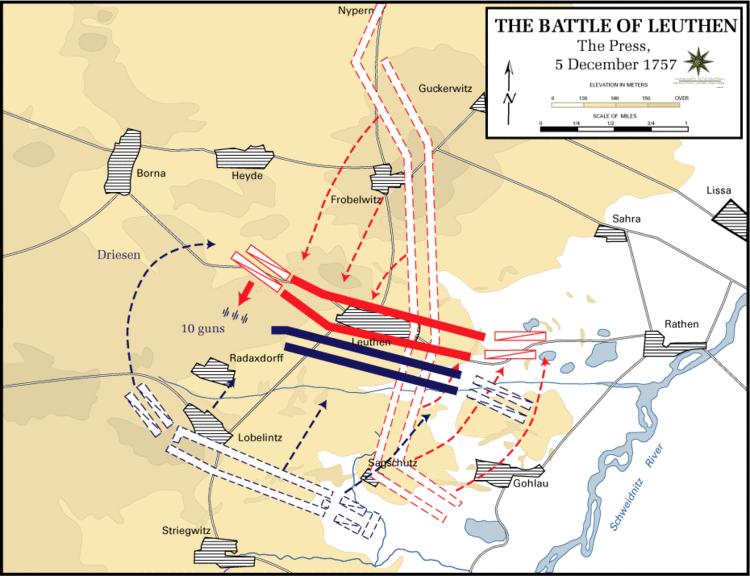
After over-running Saxony, Frederick campaigned in Bohemia and defeated the Austrians on 6 November 1757 at the Battle of Prague. Learning that French forces had invaded his ally's territory of Duchy of Hanover, Frederick moved west. On 5 November 1757, he defeated the combined French and Austrian force at the Battle of Rossbach. In his absence, the Austrians had managed to slowly retake Silesia: Prince Charles had taken the city of Schweidnitz and moved on Breslau in lower Silesia. While heading back to Silesia, Frederick learned of the fall of Breslau (22 November). He and his 22,000 men covered 274 km (170 mi) in 12 days and, at Liegnitz, joined up with the Prussian troops who had survived the fighting at Breslau. The augmented army of about 33,000 troops arrived near Leuthen (now Lutynia, Poland), 27 km (17 mi) west of Breslau, to find 66,000 Austrians in possession.
Terrain
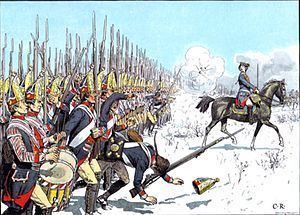
Most of Lower Silesia is a rolling plain of fertile land. It includes black and alluvial soils near Wrocław and in river valleys, mixed with more sandy soils. Its mild climate, dense, water-rich river network, and fertile soils distributed between the Oder river and the foot of the Sudetes made it a coveted agricultural resource.
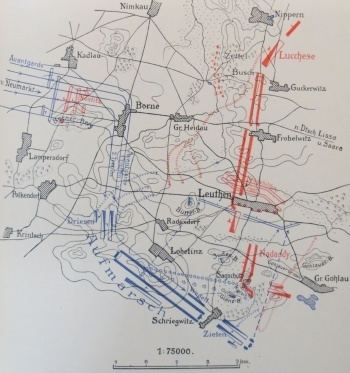
In military terms, the area northwest of Breslau was predominantly flat; while the absence of steep hills made observation of an approaching enemy easy; the flatness precluded hiding maneuvers from one's enemies. The presence of alluvial soils guaranteed relatively soft ground; not as soft as Frederick faced outside Kunersdorf in 1758, but soft enough in parts to provide a natural bog barrier to passage of troops. The area around Leuthen included several hamlets and villages: principally, Nippern, about 4 km (2 mi) north; Frobelwitz, also to the north, about halfway between Leuthen and Nippern; and Gahla to the southeast; and Lissa to the east. A roadway connected the village of Borna, Leuthen, Lissa, and, across the Oder river and its tributaries, Breslau.
Frederick had learned the countryside by heart on previous maneuvers. On 4 December 1757, astride his horse on the Schoen-Berg, a knoll about 1.5 km (1 mi) west of Borna, he surveyed the familiar landscape with his generals. A plan emerged. In front of him, a cluster of low hills dotted the landscape, in an axis approximately parallel with the Austrian line. He knew the names of the hills: Schleier-Berg, Sophien-Berg, Wach-Berg. They were hardly hills, more like hillocks, but they were high enough to provide a screen for his troops. Facing an army twice his size, he had to rely on his own army's tactical training, and use the terrain to maneuver his men into optimal position.
Dispositions
Aware of Frederick's approach, Charles positioned his army facing west on a 8 km (5 mi) front in country of undulating plains. The Prince deployed his troops in two lines, the right wing at his northernmost point, anchored at Nippern. Leuthen served as the Austrian center. Charles established his command post there, using a church tower as his observation post, and stationing seven battalions in the village itself. The majority of Charles' forces stood on his left wing. The Austrian position intersected at right angles with a principal road between Borna and Breslau, passing through Frobelwitz and Lissa. He secured the Nippern with eight grenadier companies and placed his cavalry at Guckerwitz. The Austrian line extended as far south as Sagschütz. There, his cavalry stood at right angles to the infantry, creating a line between Sagschütz and Gahla. The positions were secured with additional grenadiers and pickets. The villages, woods, abatis all had troops and the hastily erected redoubts were secured. Pickets guarded all communication points. The left wing, with cavalry placed at the far end, was also his shortest wing; the wing ended at stream and the village of Gahla.
Battle
The weather was foggy, making it difficult to see positions from either side, but Frederick and his commanders used the fog to their advantage. Leaving a cavalry unit and a cluster of infantry in front of the northernmost end of the Austrian line, Frederick deployed his forces toward Leuthen itself; Charles saw them start their redeployment, and interpreted the maneuver as withdrawal. At 4:00 on that Sunday morning, Frederick moved toward the Austrian right wing in four columns: the inner two consisting of infantry and the outer two, of cavalry. Using the knolls to block his movements, Frederick shifted the two columns of infantry and one of cavalry obliquely to his right. The left most column of cavalry remained behind to convince the Austrians that they were still approaching directly at the farthest end of the Austrian line. Their visible distraction screened Frederick's intent, which was to execute an oblique maneuver similar to that he had used to win the Battle of Rossbach. Prince Charles, watching from his vantage point, moved his reserve to his right flank. This weakened the left flank. The Prussian army had seemed to simply vanish, appearing to the Austrians as if in retreat. The Prussians continued undetected, behind those hills, across the Austrian front, and overreached (passed) the Austrian left wing.
Oblique maneuver
The Prussian infantry marched southward, remaining out of Austrian sight, behind a line of low hills. When the heads of the two superbly drilled Prussian columns – the distances between the marching platoons remaining exactly the width of each platoon's front – had passed the Austrian left flank, the columns veered left toward the enemy and continued their march until they had passed beyond the left Austrian flank. Then, on command, the platoons of the columns faced left at Lobetinz, and the whole Prussian army stood in line of battle, two to three men deep, at nearly a right angle to the Austrian left, now its weakest position. Zieten's cavalry had traversed the entire Austrian front, and positioned itself at a 45-degree angle to the Austrian flank. The Prussian artillery perched on a couple of the nearby hillocks.
The bulk of repositioned Prussian army now faced the smallest component of the Austrian force. The one column of Prussian cavalry and the small reserve of infantry remaining at the Austrian right continued to demonstrate in front of the Austrians, as if that was where the attack would occur.
Attack
The Austrians were astonished at the Prussian appearance. The intent was clear: the Prussian infantry, now arrayed in the conventional two lines of battle, advanced on the weakest part of the Austrian line, intending to roll up the flank. The colonels on the scene did the best they could: turning 90 degrees to the left, they tried to take advantage of a shallow ditch facing the Prussian line. Franz Leopold von Nádasdy, commanding the flank, asked Charles for support, a request the Prince ignored: even at late morning, with most of the Prussian army on his left flank, he still believed that any attack would come at the northern flank. Most of the men in the first line were Württembergers, Protestant troops whose willingness to fight the Lutheran Prussians had been called into question by the Austrian command. The Württembergers held out, maintaining steady musket fire until the Prussians emerged through the haze of gunpowder. Then they ran for their lives, taking with them the Bavarians Nádasdy had deployed to support his flank.
The first wave of Prussian infantry, supported by Frederick's artillery, pushed steadily toward Leuthen. The second wave came into action: commanded by Moritz of Anhalt-Dessau, the seasoned 26th Infantry went into battle with 60 rounds per man, according to Prussian regulation; by the time they overwhelmed the first Austrian line, they already were out of ammunition. Nádasdy withdrew in chaos, his troops disarrayed. Prince Charles and Daun finally realized that they had been tricked and rushed troops from the right to the left but they had rashly extended the front, originally about 4 km (2 mi) long, to almost 10 km (6 mi), when he repositioned his force earlier in the day to meet Frederick's diversion. More than two hours elapsed before his cavalry reached the center of battle; eventually, though they formed a hastily-made line along the village of Leuthen (formerly the Austrian center). Nádasdy sent his cavalry against the Prussian grenadier column and its infantry support. As the Austrians withdrew, the Prussian artillery hit them with enfilade fire.
The Prussians reached the village in forty minutes, pushing the Austrian troops into the village. Prussian Grenadiers breached the wall first and stormed the church, where many of the defenders were killed. The hand-to-hand fighting within the village raged. Charles-Joseph Lamoral, eventually Prince de Ligne, was a captain in an Austrian regiment of foot:
Our Lieutenant-Colonel fell[,] killed almost at the first; beyond this we lost our Major, and indeed all the Officers but three ... We had crossed two successive ditches, which lay in an orchard to the left of the first houses in Leuthen; and were beginning to form in front of the village. But there was no standing of it. Besides a general cannonade such as can hardly be imagined, there was a rain of case-shot upon this Battalion, of which I, as there was no Colonel left, had to take command.
Leuthen was not a big village: troops were so closely packed they stood 30 to 100 ranks deep. The killing was terrible: Lamoral commented later that his battalion, plus some Hungarians and some grenadiers who had been separated from their own companies, gave him almost (and only) 200 men. He drew them back to the height at the edge of the village, where there was a windmill around which they could shelter. Eventually, the Prussian Life Guards, commanded by Wichard Joachim Heinrich von Möllendorf, then a captain, attacked the Austrians through the village cemetery, and forced them to abandon their post.
The Austrians briefly took the advantage, when they moved a battery from the ridge north of the village to give cover to their infantry; the fire from the battery allowed the infantry to deploy at right angles to their original front. Frederick responded by ordering the last of his left wing to advance, but the Austrian battery drove it back. Finally, he established his own battery on the Butter-berg, a small knoll to the west of town, and his heavy cannons laid down a barrage. Some participants said it was this barrage, more than the Prussian infantry, which won the battle.
The assault on the wall briefly exposed General Wolf Frederick von Retzow's infantry line and the Austrian cavalry commanded by Joseph Graf Lucchesi d’ Averna hurried to take them in the flank: a successful cavalry charge could win the battle. Unfortunately for the Austrians, the 40 squadrons of Prussian cavalry waiting by Radaxdorf, commanded by Hans Joachim von Zieten, charged their flank, another 30 commanded by Georg Wilhelm von Driesen charged their front; the Bayreuth Dragoons hit their other flank, and Puttkammer Hussars charged the rear. Lucchessi was killed and his troopers, scattered. The cavalry mêlée soon swirled into the Austrian infantry line behind Leuthen, causing confusion. Over-run by the Prussian horse, the Austrian infantry broke. First the infantry, then the cavalry retreated toward Breslau, where they crossed the Weistritz, then called the Schweidnitz water.
Battle in maps
Aftermath
As the smoke cleared, the Prussian infantry reformed its lines, preparing to pursue the fleeing Austrians. Snow began to fall and Frederick halted the pursuit. A few soldiers, perhaps only one, started to sing a well-known chorale, Nun danket alle Gott (Now Thank We All Our God); eventually the entire army joined in the song. Frederick pushed toward Lissa. Refugees from the battle had filled the town, and he found the court yard of the local castle crowded with startled Austrian officers. Reportedly, after he dismounted, he said to them, "Good evening Gentlemen, I dare say you did not expect me here. Can one get a night's lodging along with you?"
After a day of rest, on 7 December Frederick sent half his cavalry with Zieten, chasing Charles' retreating army, now heading toward Königgrätz by Schweidnitz; they captured another 2000 men and baggage. With the rest of his army, Frederick marched on Breslau.
Casualties
Out of an army of approximately 66,000 men, the Austrians lost 22,000, including 3,000 dead, 7,000 wounded, and an astonishing 12,000 captured. Of the dead and wounded, Gaston Bodart estimated that almost five percent were officers; he also placed such other losses as capture and desertion at 17,000, almost 26 percent. Charles lost entire regiments, either scattered in the first attacks or overrun at the end; they simply dissolved in the waves of Prussian blue coats. The Prussians also captured 51 standards and 116 of the 250 Austrian cannons. Of the Prussian army of 36,000, Frederick lost 6,344, including 1,141 dead, 5,118 wounded and 85 captured. He lost none of his artillery. Despite the victory, its cost was high: Frederick lost one fifth of the men he had taken into battle.
The battle presented a severe blow to Austrian morale. They had been soundly beaten by an army half their size, with fewer guns, tired after a long march over 12 days. Charles and his second in command, Count Leopold Joseph von Daun, sank "in the depths of despondency", and the Prince could not fathom what had happened. Although Charles had been moderately successful against Frederick in past encounters, after this defeat, Maria Theresa replaced him with Daun; Charles retired from military service.
By chasing Charles' army into Bohemia, the Prussians guaranteed the isolation of the Austrian garrison holding Breslau. The Austrian general left in command of the city, Lieutenant Field Marshal Salman Sprecher von Bernegg, had a combined garrison of French and Austrian men, 17,000 strong. Breslau itself was a strongly fortified city of walls and moats. The Austrians were determined to hold Breslau, not only because losing it would cost them control of Silesia and considerable loss in prestige, but also for the immense quantities of stores it held. The Austrian commander, recognizing his grim plight, posted placards on gallows and poles throughout the city, warning anyone who spoke of surrender would be instantly hanged. On 7 December, Frederick laid siege to the city and the future of Austrian control looked grim.
Assessments
Frederick had benefited from an obliging enemy: Charles saw what he wanted to see regarding the principal attack, instead of using his efficient light cavalry to figure out what the Prussians really intended. Frederick commented later that a lone patrol could have uncovered the truth. The cavalry he had left demonstrating in front of the northern most position of the Austrian line was simply a screen, a diversion, to hide his real movements. Second, the Austrians obliged him by their failure to post pickets on their unprotected flank south of Leuthen. Nádasdy's omission of outposts on his open flank was a surprising failure for a man with his long years of experience against the Prussians; he should have considered the possibility of an attack from an unexpected direction.
It was Frederick greatest victory so far, and showed the world, meaning Europeans, the superiority of Prussian infantry at the time. In one day, Frederick wiped out the victories the Austrians had achieved earlier in the year at Breslau and Schweidnitz, and the inroads the Austrians had made into Silesia. It also demonstrated 18th century linear tactics at their best. Frederick had learned some valuable lessons at Prague and Kolin: when his infantry had run out of ammunition and lost initiative. At Leuthen, he had ammunition wagons brought from the artillery park and posted behind the advancing line of grenadiers and infantry battalions. Infantry could be resupplied quickly, without losing the initiative. Consequently, although some infantrymen fired 180 rounds, the advance never bogged down in exchanges of musketry. The Prussian cavalry protected the flanks, and this provided to tactically important charges, which turned the defeat into a rout. The horse artillery not only maintained its fire, but it kept pace with the army and deployed and redeployed its guns. Furthermore, the 12-pounders, which have a distinctive bellow, contributed to Prussian morale and wrought havoc on the Austrians in Leuthen.
The victory also changed the thinking of Frederick's enemies. Before the battle, he was often referred to in unflattering, even demeaning, ways; after Leuthen, he was widely called the King of Prussia, in both polite and general circles. This victory, plus the one at Rossbach, earned for Frederick some general respect and fear that even his most bitter of enemies maintained for the rest of the war. Furthermore, Leuthen, combined with the earlier Rossbach, in all probability saved Prussia from extinction. A half century later, Napoleon called it "a masterpiece of movements, maneuvers and resolution."
Memorials
A memorial erected in 1854 honored the Prussian army at Leuthen. King Frederick William IV ordered a victory column with a gilded goddess of victory at Heidau, (5 km (3 mi) southeast of Lissa). The design for the monument was provided by the Berlin architect Friedrich August Stüler, and the goddess of victory by Christian Daniel Rauch. The column was created in the workshop of the sculptor Heinrich Menzel from Neisse in local white-gray. The plinth and the goddess were executed by Moritz Geiss in zinc casting; the statue Victoria was also gilded for better effect. The total height of the monument was 20 meters (66 ft). The monument was dynamited during World War II, and only ruins of the pedestal remain.
